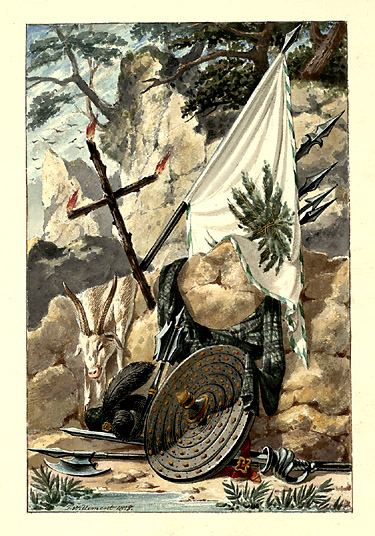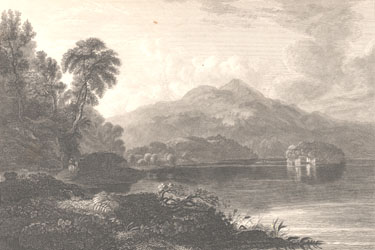|
|
Home | Corson
Collection | Biography | Works | Image
Collection | Recent
Publications | Portraits | Correspondence | Forthcoming
Events | Links | E-Texts | Contact
The Lady of the Lake
First Edition, First Impression:
The Lady of the Lake; A Poem. By Walter Scott, Esq. Edinburgh:
Printed for John Ballantyne and Co. Edinburgh; and Longman, Hurst,
Rees and Orme, and William Miller, London; By James Ballantyne and
Co. Edinburgh 1810.
Composition | Synopsis | Reception | Links
Composition
 Scott began writing The Lady of the Lake in August 1809 while holidaying
with his wife, Charlotte, and
daughter, Sofia, in the Trossachs and along the shores and islands of Loch
Katrine, the very scenes that would provide the poem's setting. With this
new poem, though, Scott wished to depend less on local colour and spectacular
action and to attain greater psychological depth in his characterization.
As he worked on the poem, Scott felt that, in this respect, it would only
be a partial success. While he was confident that he had brought King James
V and the clan chieftain Roderick Dhu vividly to life, he feared that the
romantic hero, Malcolm Graeme would remain 'a perfect automaton' (letter
to Lady Abercorn, March 14, 1810). Although initial progress on the poem
was rapid, work was delayed when his children Walter, Charles, and Anne
fell dangerously ill with an inflammatory fever. Only when they had fully
recovered was he able to complete the poem which was published on May 8,
1810. Scott began writing The Lady of the Lake in August 1809 while holidaying
with his wife, Charlotte, and
daughter, Sofia, in the Trossachs and along the shores and islands of Loch
Katrine, the very scenes that would provide the poem's setting. With this
new poem, though, Scott wished to depend less on local colour and spectacular
action and to attain greater psychological depth in his characterization.
As he worked on the poem, Scott felt that, in this respect, it would only
be a partial success. While he was confident that he had brought King James
V and the clan chieftain Roderick Dhu vividly to life, he feared that the
romantic hero, Malcolm Graeme would remain 'a perfect automaton' (letter
to Lady Abercorn, March 14, 1810). Although initial progress on the poem
was rapid, work was delayed when his children Walter, Charles, and Anne
fell dangerously ill with an inflammatory fever. Only when they had fully
recovered was he able to complete the poem which was published on May 8,
1810.
Back to top
Synopsis
 The narrative of the poem concerns the struggle between King James
V and the powerful clan Douglas. The King has banished the entire
family from his realm, including James of Douglas, the Earl of Bothwell,
who had been his protector during his youth. The Earl and his daughter
Ellen take refuge with Roderick Dhu in his castle on an island in
Loch Katrine. At the beginning of the poem a mysterious knight calling
himself James Fitz-James arrives at the castle and is granted hospitality.
During his brief stay, he falls in love with Ellen but finds rivals
for her affections in Roderick himself and in Malcolm Graeme, a
young knight loyal to the King but moved by sympathy at the plight
of Douglases. It is Malcolm that Ellen favours. Facing attack from
royal forces for sheltering Douglas, Roderick gathers his clan.
Douglas, though, is loath to bring disaster upon his host, and sets
out for the royal court at Stirling, determined to surrender. Fitz-James
returns and offers to take Ellen to safety but is told that she
loves another. He nonetheless presses on her a ring which, he says,
will obtain any favour from the King. Travelling to Stirling, Fitz-James
meets and quarrels with Roderick. In the ensuing fight, Roderick
is mortally wounded and carried to Stirling as a captive. Ellen
presents herself at court and, showing the ring, pleads for her
father's pardon. She discovers that Fitz-James is no other than
the King himself. The King and Douglas are reconciled through her
intervention, and Ellen and Malcolm marry. The narrative of the poem concerns the struggle between King James
V and the powerful clan Douglas. The King has banished the entire
family from his realm, including James of Douglas, the Earl of Bothwell,
who had been his protector during his youth. The Earl and his daughter
Ellen take refuge with Roderick Dhu in his castle on an island in
Loch Katrine. At the beginning of the poem a mysterious knight calling
himself James Fitz-James arrives at the castle and is granted hospitality.
During his brief stay, he falls in love with Ellen but finds rivals
for her affections in Roderick himself and in Malcolm Graeme, a
young knight loyal to the King but moved by sympathy at the plight
of Douglases. It is Malcolm that Ellen favours. Facing attack from
royal forces for sheltering Douglas, Roderick gathers his clan.
Douglas, though, is loath to bring disaster upon his host, and sets
out for the royal court at Stirling, determined to surrender. Fitz-James
returns and offers to take Ellen to safety but is told that she
loves another. He nonetheless presses on her a ring which, he says,
will obtain any favour from the King. Travelling to Stirling, Fitz-James
meets and quarrels with Roderick. In the ensuing fight, Roderick
is mortally wounded and carried to Stirling as a captive. Ellen
presents herself at court and, showing the ring, pleads for her
father's pardon. She discovers that Fitz-James is no other than
the King himself. The King and Douglas are reconciled through her
intervention, and Ellen and Malcolm marry.
Back to top
Reception
The Lady of the Lake marked the pinnacle of Scott's popularity
as a poet. With 25,000 copies sold in eight months, it broke all
records for the sale of poetry, and Scott's fame spread beyond Great
Britain to the United States. The critics almost matched the enthusiasm
of the public. In the Edinburgh Review, the habitually glacial
Francis Jeffrey felt it far exceeded its predecessors: the story
was 'constructed with infinitely more skill and address' and there
was 'a larger variety of characters, more artfully and judiciously
contrasted'. For the British Critic, the story itself was
more interesting than in Scot's earlier poems, but the poem's real
charm lay in 'painting real manners; and displaying the character
of an interesting because singular people'. Reservations were expressed
by the Critical Review which thought Canto III superfluous
and by the Rev. Francis Hodgson in the Monthly Review, for
whom the composition careless and the language barbaric. The public,
though, continued to devour the poem. Sightseers flocked to Loch
Katrine, and a hotel was built at Callander catering for those who
wished to visit 'Ellen's Isle'. The Lady of the Lake created
a vogue for the Trossachs and is primarily responsible for the area's
enduring popularity with tourists.
Back to top

Links
Back to Index of Works
Last updated: 19-Dec-2011
© Edinburgh University Library
|
|

 Scott began writing The Lady of the Lake in August 1809 while holidaying
with his wife,
Scott began writing The Lady of the Lake in August 1809 while holidaying
with his wife,  The narrative of the poem concerns the struggle between King James
V and the powerful clan Douglas. The King has banished the entire
family from his realm, including James of Douglas, the Earl of Bothwell,
who had been his protector during his youth. The Earl and his daughter
Ellen take refuge with Roderick Dhu in his castle on an island in
Loch Katrine. At the beginning of the poem a mysterious knight calling
himself James Fitz-James arrives at the castle and is granted hospitality.
During his brief stay, he falls in love with Ellen but finds rivals
for her affections in Roderick himself and in Malcolm Graeme, a
young knight loyal to the King but moved by sympathy at the plight
of Douglases. It is Malcolm that Ellen favours. Facing attack from
royal forces for sheltering Douglas, Roderick gathers his clan.
Douglas, though, is loath to bring disaster upon his host, and sets
out for the royal court at Stirling, determined to surrender. Fitz-James
returns and offers to take Ellen to safety but is told that she
loves another. He nonetheless presses on her a ring which, he says,
will obtain any favour from the King. Travelling to Stirling, Fitz-James
meets and quarrels with Roderick. In the ensuing fight, Roderick
is mortally wounded and carried to Stirling as a captive. Ellen
presents herself at court and, showing the ring, pleads for her
father's pardon. She discovers that Fitz-James is no other than
the King himself. The King and Douglas are reconciled through her
intervention, and Ellen and Malcolm marry.
The narrative of the poem concerns the struggle between King James
V and the powerful clan Douglas. The King has banished the entire
family from his realm, including James of Douglas, the Earl of Bothwell,
who had been his protector during his youth. The Earl and his daughter
Ellen take refuge with Roderick Dhu in his castle on an island in
Loch Katrine. At the beginning of the poem a mysterious knight calling
himself James Fitz-James arrives at the castle and is granted hospitality.
During his brief stay, he falls in love with Ellen but finds rivals
for her affections in Roderick himself and in Malcolm Graeme, a
young knight loyal to the King but moved by sympathy at the plight
of Douglases. It is Malcolm that Ellen favours. Facing attack from
royal forces for sheltering Douglas, Roderick gathers his clan.
Douglas, though, is loath to bring disaster upon his host, and sets
out for the royal court at Stirling, determined to surrender. Fitz-James
returns and offers to take Ellen to safety but is told that she
loves another. He nonetheless presses on her a ring which, he says,
will obtain any favour from the King. Travelling to Stirling, Fitz-James
meets and quarrels with Roderick. In the ensuing fight, Roderick
is mortally wounded and carried to Stirling as a captive. Ellen
presents herself at court and, showing the ring, pleads for her
father's pardon. She discovers that Fitz-James is no other than
the King himself. The King and Douglas are reconciled through her
intervention, and Ellen and Malcolm marry. 